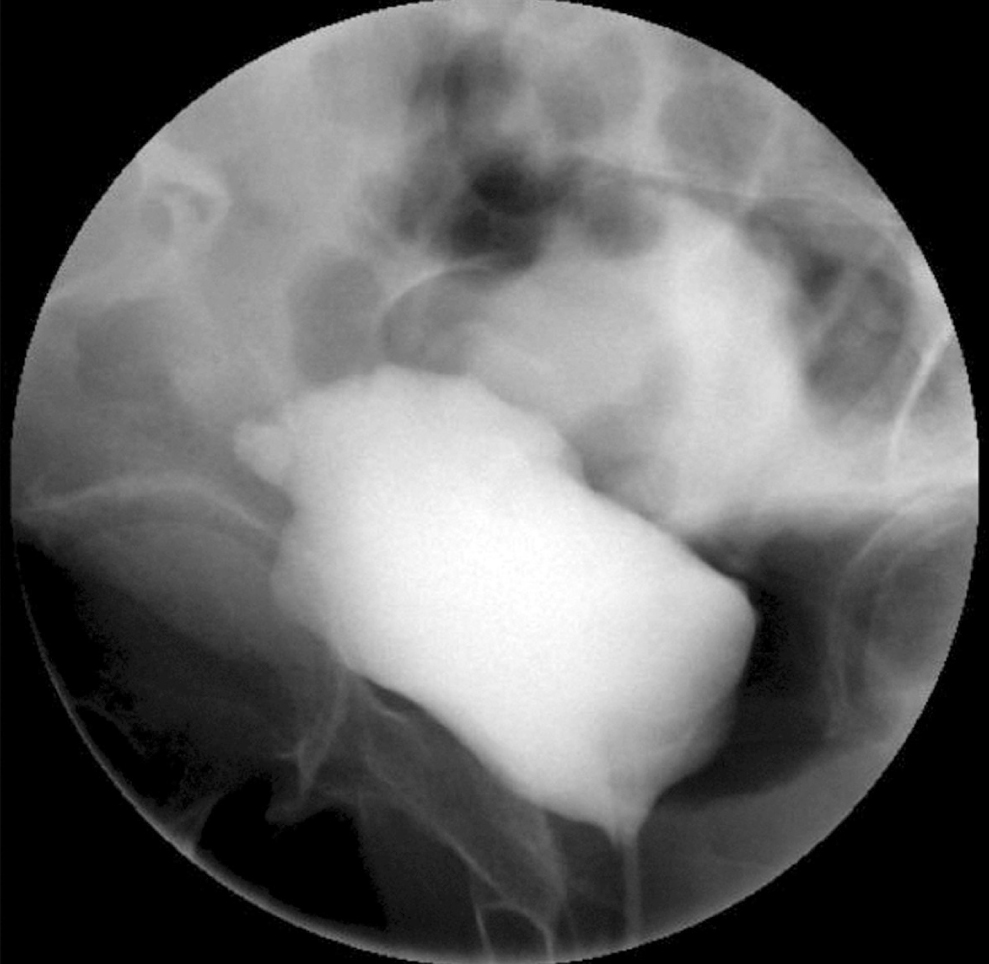Uroperitoneo como causa de ascitis recurrente. Una etiología que no debe ser olvidada
DOI:
https://doi.org/10.22516/25007440.931Palabras clave:
Ascitis, Lesión renal aguda, UroperitoneoResumen
La ascitis es una condición frecuente con una etiología variable; dentro de esta, el uroperitoneo es una causa infrecuente con un cuadro clínico inespecífico y de difícil diagnóstico que requiere una aproximación minuciosa y una alta sospecha clínica para un adecuado enfoque. Para su correcto diagnóstico, juega un papel fundamental la medición de creatinina en el líquido peritoneal, en el suero y su gradiente. Presentamos el caso de un paciente con ascitis recurrente y elevación fluctuante de azoados que fue diagnosticado con uroperitoneo luego de una aproximación juiciosa. La evolución fue apropiada luego de la intervención quirúrgica sin nuevas recurrencias.
Descargas
Referencias bibliográficas
Rudler M, Mallet M, Sultanik P, Bouzbib C, Thabut D. Optimal management of ascites. Liver Int. 2020;40(S1):128-35. https://doi.org/10.1111/liv.14361
Angeli P, Bernardi M, Villanueva C, Francoz C, Mookerjee RP, Trebicka J, et al. EASL Clinical Practice Guidelines for the management of patients with decompensated cirrhosis. J Hepatol. 2018;69(2):406-60. https://doi.org/10.1016/j.jhep.2018.03.024
Ginés P, Quintero E, Arroyo V, Terés J, Bruguera M, Rimola A, et al. Compensated cirrhosis: Natural history and prognostic factors. Hepatology. 1987;7(1):122-8. https://doi.org/10.1002/hep.1840070124
Tarn AC, Lapworth R. Biochemical analysis of ascitic (peritoneal) fluid: what should we measure? Ann Clin Biochem. 2010;47(5):397-407. https://doi.org/10.1258/acb.2010.010048
Simler MAZ, Desouky E, Zakharious F, Mandal AKJ, Missouris CG. A Syndrome of Apparent Renal Failure. Ann Emerg Med. 2020;76(2):191-3. https://doi.org/10.1016/j.annemergmed.2020.02.018
Aithal GP, Palaniyappan N, China L, Härmälä S, Macken L, Ryan JM, et al. Guidelines on the management of ascites in cirrhosis. Gut. 2021;70(1):9-29. https://doi.org/10.1136/gutjnl-2020-321790
Runyon BA. The Serum-Ascites Albumin Gradient Is Superior to the Exudate-Transudate Concept in the Differential Diagnosis of Ascites. Ann Intern Med. 1992;117(3):215. https://doi.org/10.7326/0003-4819-117-3-215
Rodríguez Vargas BO, Monge Salgado E, Montes Teves P, Salazar Ventura S, Guzmán Calderón E. Diagnostic of ascites due to portal hypertension: accuracy of the serum-ascites albumin gradient and protein analises in ascitic fluid. Rev Gastroenterol Peru. 2014;34(1):23-8.
Hou W, Sanyal AJ. Ascites: Diagnosis and Management. Medical Clinics of North America. 2009;93(4):801-17. https://doi.org/10.1016/j.mcna.2009.03.007
Kant S, Menez S, Hanouneh M, Fine DM. Close encounters of the peritoneal kind: case series and literature review of uroperitoneum. Lessons for the clinical nephrologist. J Nephrol. 2021;34(3):939-42. https://doi.org/10.1007/s40620-020-00867-1
Ridinger HA, Kavitt RT, Green JK. Urinary Ascites and Renal Failure from Unrecognized Bladder Rupture. Am J Med. 2012;125(9):e1-2. https://doi.org/10.1016/j.amjmed.2012.01.019
Charalampidis S, Petrides C, Charalampous C, Stavrou S. Hyponatremic Renal Pseudofailure and Massive Ascites Following Normal Vaginal Delivery: A Diagnostic and Therapeutic Challenge. Renal Failure. 2012;34(2):237-40. https://doi.org/10.3109/0886022X.2011.647206
Manahan K. Peritoneal fluid urea nitrogen and creatinine reference values. Obstetrics & Gynecology. 1999;93(5):780-2. https://doi.org/10.1016/S0029-7844(98)00516-X
Nguyen-Khac E, Thevenot T, Capron D, Dharancy S, Paupart T, Thabut D, et al. Are ascitic electrolytes usable in cirrhotic patients? Correlation of sodium, potassium, chloride, urea, and creatinine concentrations in ascitic fluid and blood. European J Int Med. 2008;19(8):613-8. https://doi.org/10.1016/j.ejim.2007.07.011
Martens P. Pseudorenal Failure Secondary to Reversed Intraperitoneal Autodialysis. Case Rep Nephrol. 2013;2013:1-3. https://doi.org/10.1155/2013/982391
Kim JH, Yang WJ. Delayed spontaneous perforation of urinary bladder with intraperitoneal seeding following radical transurethral resection of invasive urothelial cancer: a case report. BMC Res Notes. 2014;7(1):167. https://doi.org/10.1186/1756-0500-7-167
Pogatchnik B, Monti S, Lewis DH, Heinrich DA, Mannelli L. Intraperitoneal Urine Leak After Prostatectomy Confirmed by 99mTc-MAG3 Renogram. Clinical Nuclear Medicine. 2014;39(8):744-6. https://doi.org/10.1097/RLU.0000000000000442
Teeluckdharry B, Gilmour D, Flowerdew G. Urinary Tract Injury at Benign Gynecologic Surgery and the Role of Cystoscopy: A Systematic Review and Meta-analysis. Obstetrics & Gynecology. 2015;126(6):1161-9. https://doi.org/10.1097/AOG.0000000000001096
Rajasekar D, Hall M. Urinary tract injuries during obstetric intervention. BJOG. 1997;104(6):731-4. https://doi.org/10.1111/j.1471-0528.1997.tb11986.x
Cohen AJ, Packiam VT, Nottingham CU, Pariser JJ, Faris SF, Bales GT. Iatrogenic Bladder Injury: National Analysis of 30-Day Outcomes. Urology. 2016;97:250-6. https://doi.org/10.1016/j.urology.2016.05.002
Harding AE, Scott J, Jefferson M. Bladder rupture in multiple sclerosis. BMJ. 1977;1(6056):270-270. https://doi.org/10.1136/bmj.1.6056.270
Bastable JRG, Jode LRD, Warren RP. Spontaneous rupture of the bladder. Brit J Urol. 1959;31(1):78-86. https://doi.org/10.1111/j.1464-410X.1959.tb09386.x
Fujikawa K, Yamamichi F, Nonomura M, Soeda A, Takeuchi H. Spontaneous Rupture of the Urinary Bladder Is Not a Rare Complication of Radiotherapy for Cervical Cancer: Report of Six Cases. Gynecologic Oncology. 1999;73(3):439-42. https://doi.org/10.1006/gyno.1999.5347
Lin ACM, Juang GD, Huang CH, Tso CY. An unusual cause of iatrogenic bladder rupture. Am J Emerg Med. 2006;24(4):512-4. https://doi.org/10.1016/j.ajem.2005.11.018
Sivakumar V, Sivaramakrishna G, Abirami K, Lakshmi A. Urinary ascites. Indian J Nephrol. 2012;22(2):143. https://doi.org/10.4103/0971-4065.97140
Bourgeois S, Decupere M, Devriendt D, Lesage K, Van Moerkercke W. A case of pseudorenal failure - spontaneous rupture of the urinary bladder. Acta Gastroenterol Belg. 2017;80(3):419-21.
Mischianu D, Bratu O, Ilie C, Madan V. Notes concerning the peritonitis of urinary aetiology. J Med Life. 2008;1(1):66-71.
Mark A, Meister M, Opara B, Chow R. Nontraumatic urinary bladder rupture presenting as renal pseudo-failure and ascites. Radiology Case Reports. 2017;12(2):304-7. https://doi.org/10.1016/j.radcr.2017.03.005
Goto S, Yamadori M, Igaki N, Kim JI, Fukagawa M. Pseudo-azotaemia due to intraperitoneal urine leakage: a report of two cases. NDT Plus. 2010;3(5):474-6. https://doi.org/10.1093/ndtplus/sfq107
Wang YC, Lin JD, Hung SC. A woman with ascites and oliguria. Clin Kidney J. 2013;6(5):545-6. https://doi.org/10.1093/ckj/sft103
Wystrychowski A, Nowicki M, Kokot F. Hyponatraemic renal pseudofailure--don’t forget the possibility of uroperitoneum. Nephrol Dial Transplant. 1996;11(12):2491-2. https://doi.org/10.1093/oxfordjournals.ndt.a027222
Eymin LG, Trucco BC, Andresen HM. Ascitis y falla renal: no olvidar el uroperitoneo. Rev Méd Chile. 2006;134(3):345-347. https://doi.org/10.4067/S0034-98872006000300012
Quagliano PV, Delair SM, Malhotra AK. Diagnosis of Blunt Bladder Injury: A Prospective Comparative Study of Computed Tomography Cystography and Conventional Retrograde Cystography: J Trauma. 2006;61(2):410-21. https://doi.org/10.1097/01.ta.0000229940.36556.bf
Fouladi DF, Shayesteh S, Fishman EK, Chu LC. Imaging of urinary bladder injury: the role of CT cystography. Emerg Radiol. 2020;27(1):87-95. https://doi.org/10.1007/s10140-019-01739-3
Ajape A, Abdulkadir A, Babata A, Adesiyun O. Spontaneous Intra-Peritoneal Urinary Bladder Rupture Complicating Benign Prostate Hyperplasia: Case Report. Ann Afr Surg. 2011;7(1):62-5. https://doi.org/10.4314/aas.v7i1.67034

Descargas
Publicado
Cómo citar
Número
Sección
Licencia
Derechos de autor 2023 Revista colombiana de Gastroenterología

Esta obra está bajo una licencia internacional Creative Commons Atribución-NoComercial-SinDerivadas 4.0.
Aquellos autores/as que tengan publicaciones con esta revista, aceptan los términos siguientes:
Los autores/as ceden sus derechos de autor y garantizarán a la revista el derecho de primera publicación de su obra, el cuál estará simultáneamente sujeto a la Licencia de reconocimiento de Creative Commons que permite a terceros compartir la obra siempre que se indique su autor y su primera publicación en esta revista.
Los contenidos están protegidos bajo una licencia de Creative Commons Reconocimiento-NoComercial-SinObraDerivada 4.0 Internacional.


















